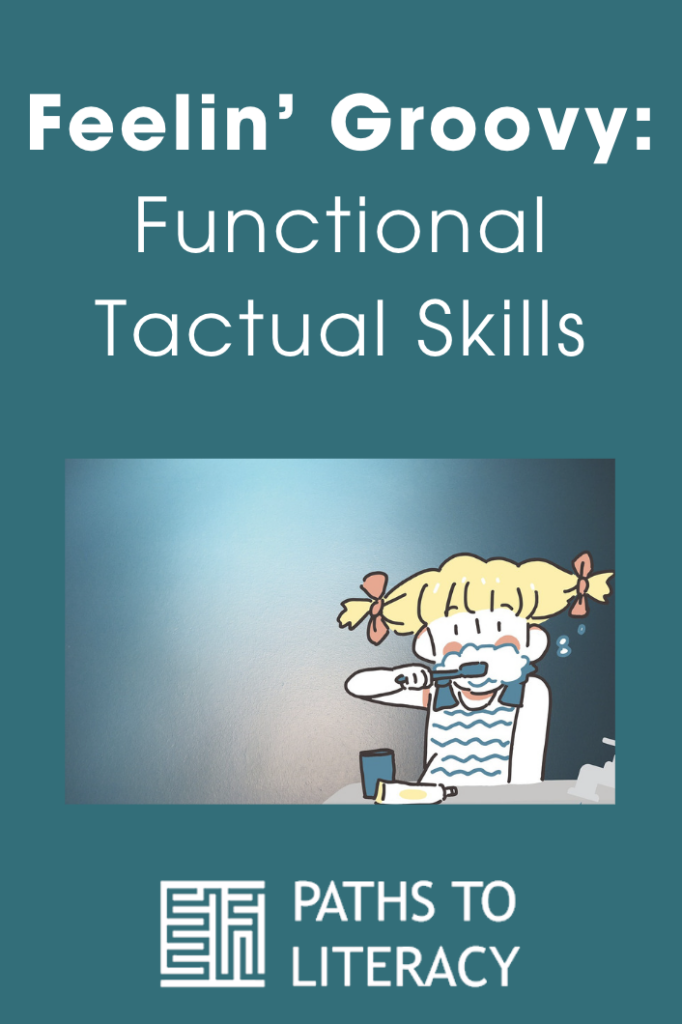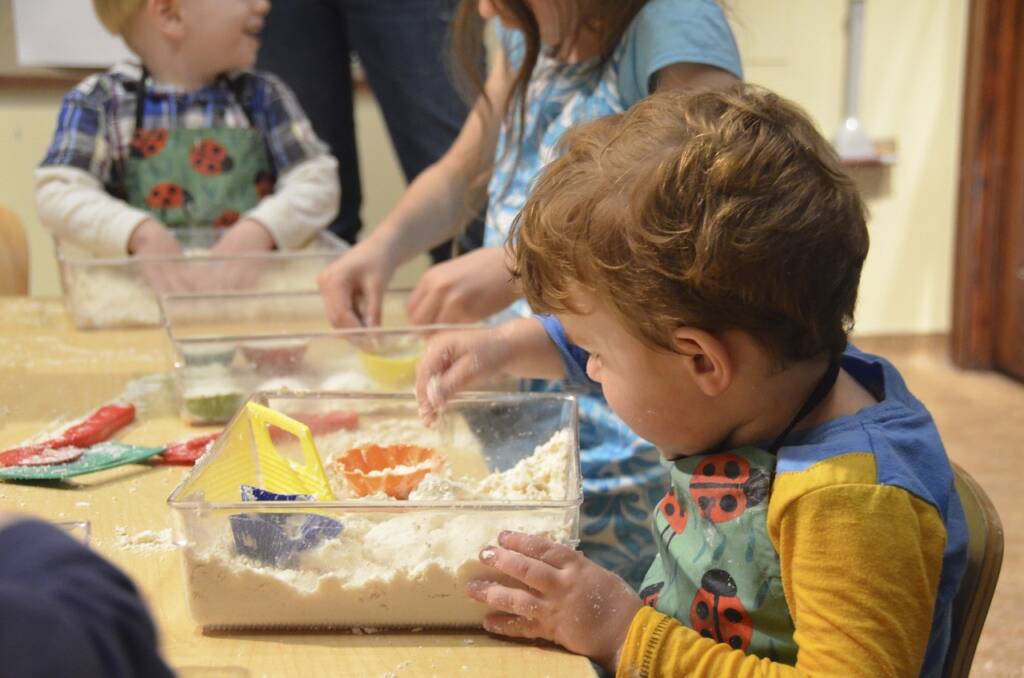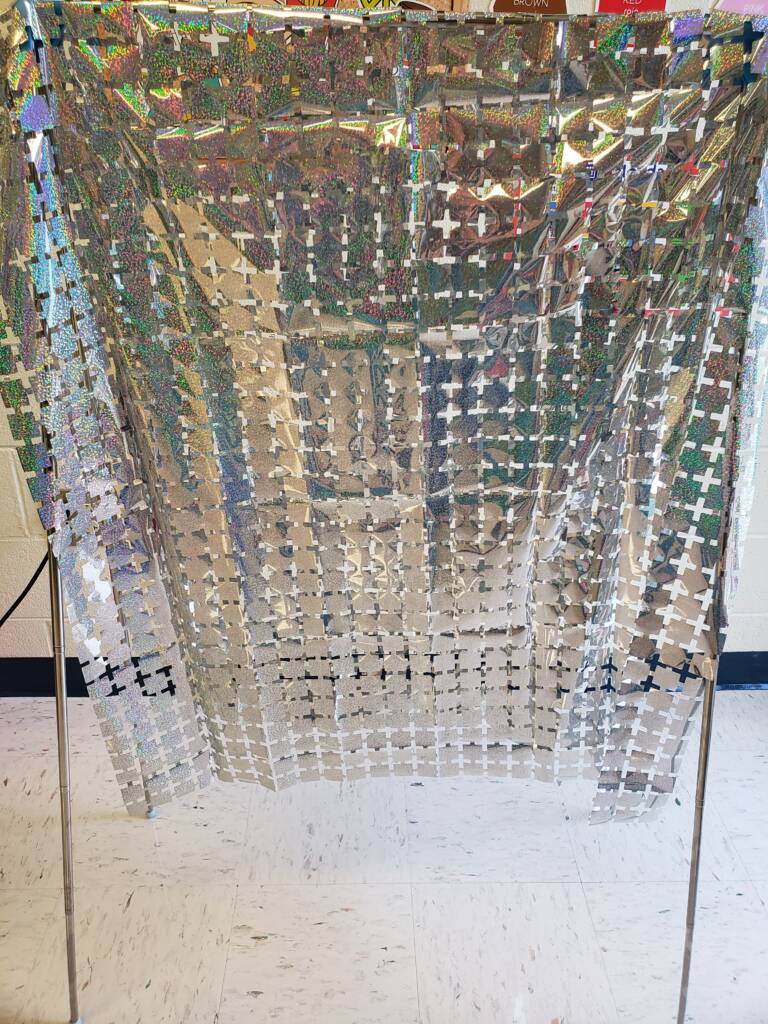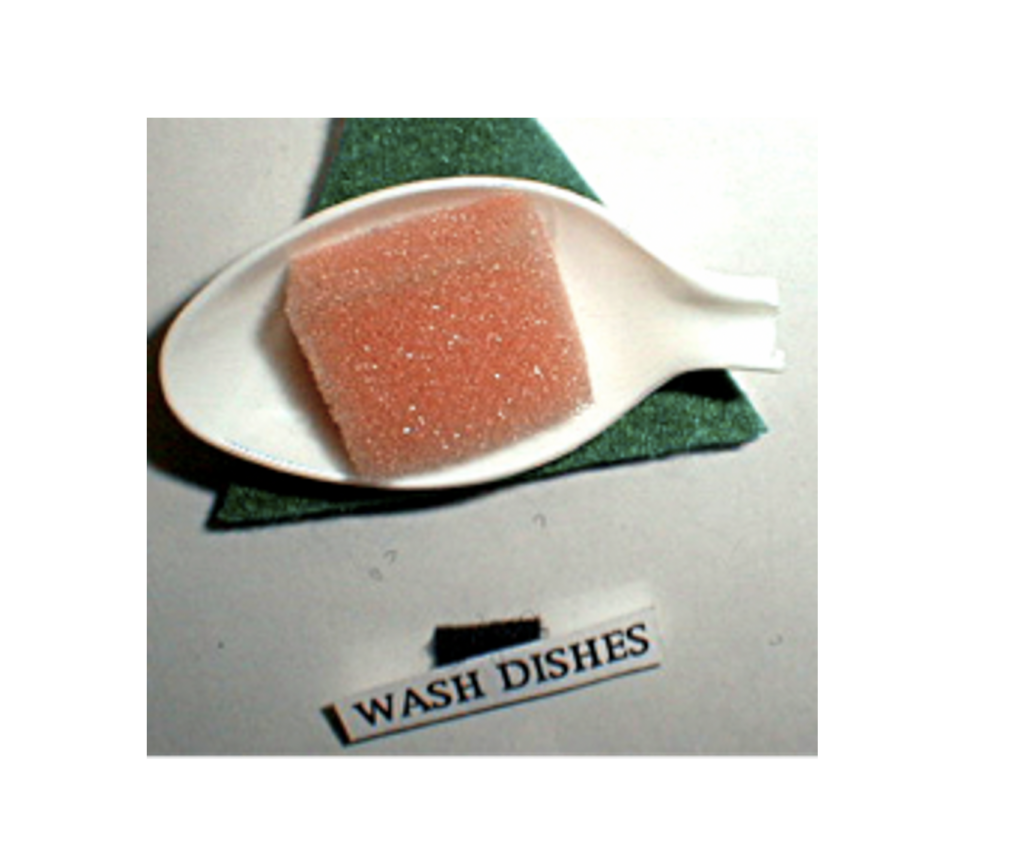By Millie Smith, Education Specialist, TSBVI VI Outreach with help from Roger Toy, Occupational Therapist, TSBVI
Johnny is an eight year old child with visual and multiple impairments. He has some light perception and fairly good voluntary movement in his upper extremities although he can’t walk. He is about to engage in an activity designed to teach him to brush his teeth. The brush suddenly appears in Johnny’s hand. His teacher places her hand over his. The pressure applied to hold the brush is hers. The thought processes to plan the movement of the brush is hers. The spatial memory used to move and place the brush is hers. Finally, her hand and the brush are gone. Toothbrushing is finished. What has Johnny learned? He has learned to be passive and to tolerate having his hands moved for him.
Many teachers and parents of children with visual and multiple impairments are told to provide a level of assistance during activities commonly called “hand over hand.” When done correctly with permission, minimal direction and appropriate waiting time, this teaching strategy can be very effective. When done incorrectly with complete other-directed manipulation throughout a task, children lose control of their hands and any potential they might have for learning through the tactual medium. They risk becoming increasingly passive by pulling their hands away and rejecting objects. These students may not actually be tactually defensive, but rather tactually avoidant. Instead of using their hands as tools to interact more and more with the world outside their bodies, they withdraw, turn ever more inward, and spend most of their time engaging in self-stimulatory behaviors. Like Johnny, they have learned to be helpless.
Encouraging Johnny to use his hands confidently and competently to access information about his world and to interact with his world to the fullest extent of his ability requires a two-part intervention. First, create a supportive learning environment and then, facilitate development of functional tactual skills.
Creating a Supportive Learning Environment
Children with visual and multiple impairments tend to have very limited experience with objects. They often form strong attachments to one or two objects and reject everything else. What they choose to do with the objects may be nonfunctional and repetitive. Our job is to widen the experience of these children to include a rich variety of objects and interactions. To do that we must establish a relationship grounded in mutual respect and trust. The key to a trusting and respectful relationship with a child who can’t see is to begin by acknowledging that he has a right to control his own hands in exactly the same way that we have a right to control what we look at. We all want to facilitate learning, and the fastest and easiest way to do that is to grab a child’s hands. As frustrating as it might be for us at times, development is best facilitated by encouraging rather than demanding (Nielsen).
Why won’t Johnny hold his toothbrush?
There are probably many reasons Johnny won’t hold his toothbrush assuming he has the motor ability to grasp. When the brush is placed in his hand, he may not know what it is. Most people experience some anxiety about touching something unknown, even when they are in control of the touching. That’s why we blindfold people in Halloween fun houses and ask them to feel creepy stuff. Children who cannot see what is around them may be understandably reluctant to touch and hold the unknown (Fraiberg). Or, Johnny may know the object is a toothbrush, but not know what he is supposed to do with it. He may be dropping the toothbrush because he has not memorized the sequence of movements that goes with the rest of the activity (Millar). Another possibility is that Johnny recognizes the brush and anticipates that something he doesn’t like is about to happen. He may drop the brush because he hopes that will prevent someone from grabbing his hands and brushing his teeth.
So what do I do to create a more supportive learning environment?
If Johnny won’t hold anything and he doesn’t like brushing teeth, we can’t start with a toothbrush. We have to start with creating a trusting relationship with Johnny. We demonstrate that we can provide an environment that contains things that he likes to touch and hold. We also demonstrate that Johnny can be in control of his own hands. He can control what he wants to touch, what he wants to do with it, and when he wants to stop. It is very important to acknowledge that no teacher or parent will ever do this perfectly. The good news is that children don’t seem to require perfection in order to trust us. As long as we are letting them be in control of their hands most of the time, we will probably have the relationship we need.
Here are some suggestions for how to build this relationship:
- Offer an object by making a sound with it close to the child or by using the object to touch some part of the body less sensitive than the palm of the hand, usually the arm or leg (Nielsen). Wait for a reach. Repeat the offer if necessary. Do not repeat the offer immediately if the child has a negative response. Offer something else. It is fine to offer something previously rejected at a later time as long as the object is quickly removed if rejected again and as long as the original rejection wasn’t extreme.
- Engage in parallel play guided by the child. After the child does something with an object, imitate his action. Try to prolong the interaction by taking turns, he with his object, and you doing the same thing with a like object or a shared object (Nielsen).
- Model new actions with the object of interest. Offer your hands to the child as you do something with an object. Place your hands under the child’s hands, but don’t persist in maintaining contact if he removes his hands. This is the “hand-under-hand” method (Miles).
- Create safe, consistent, interesting object environments. The child should have total control over these environments. No one should guide his hands or verbally direct his activity when he is in these special environments (Nielsen). Make sure these environments are rich. Some plastic toys are okay if they are favorites, but most children find things like screen door springs and wind chimes much more interesting. Be sure to take the usual choking-hazard precautions.
- Always ask permission before taking the child’s hand. This can be done non-verbally by placing your hand on top of the child’s hand. If the child does not remove his hand, proceed.
- Always cue the child so that he knows what you are going to do before you take his hand. For example, give the child a spoon to let him know it is time to eat.
- If the child is resisting attempts to engage his hands, leave his hands alone and drop back to reciprocal whole body interactions such as rocking, swinging, bouncing, etc. Remember you are using these interactions to build trust so that the child will value time spent with you. In these interactions, the child will use his body to signal when he wants you to continue or stop (Van Dijk). As he develops trust that you will respond to these signals, he will be more likely to expand his contact with you to eventually include hands.
Yes, but, how do those teeth get brushed?
So, if you know Johnny likes things that vibrate, you offer him a vibrating toothbrush by turning it on close to his head. He might reach over and touch it. If you hold it there so he understands that he is in control of what happens next, he might grasp it. If you turn loose at this point, he might hold it. Then you let him do anything he wants with it. Don’t blow the trust by grabbing his hand and making him brush. Johnny needs to memorize movement sequences in activities he really likes before you take on toothbrushing. In the meantime he is learning that he can trust you while he is also finding out a few things about the parts of a toothbrush. Later this will come in handy when you use a brush to cue him that you are going to brush his teeth and he recognizes it. Yes, teeth still have to be brushed, just don’t touch Johnny’s hands while you are doing it. If he brings his hands up to yours and participates a little with his hand over yours, you will know that you are making progress. Johnny may begin bringing his hand up to push yours away to signal that he wants you to stop. Honor this communication by stopping for a moment. Then begin again. Johnny has learned that he can use his hand to create short breaks. He may try for more, perhaps controlling the amount of pressure you apply or where you place the brush. As Johnny learns that he has more and more control over the activity when his hands are involved, the involvement will gradually increase.
Facilitating the development of functional tactual skills
The cognitive, communicative and social development of children who are tactual learners depends to a large extent on how much information they can access by using their hands and other parts of their bodies to touch and move. A short clarification might be helpful here. The children we commonly refer to as “tactual learners” are really somatosensory learners. The somatosensory system includes the tactile, proprioceptive, and kinesthetic components of perception. The proprioceptive and kinesthetic components relay information to the brain about the position of parts of the body and about what they are doing (Nagaishi). Braille reading is really not a tactual skill; it is a somatosensory skill. The discrimination of the individual characters is primarily tactual, but all the braille fluency skills, finding the next line, etc., are primarily proprioceptive and kinesthetic. For a child without vision, the same perceptual components apply to eating, finding a favorite toy and just about everything else. Historically, one of the highest job priorities for teachers of the visually impaired has been the development of somatosensory skills for children who are potential braille readers. For some reason, there has not been much emphasis in the field of visual impairments on the development of somatosensory skills for students with multiple impairments. In many places the role of the teacher of the visually impaired with this population has been limited to vision stimulation activities (Lewis). Children with visual and multiple impairments are often passively manipulated through tasks without due consideration to building a sound somatosensory base of knowledge about the world.
Why does the teacher of the visually impaired need to be involved; can’t the occupational therapist do it?
There is some overlap between the roles of the occupational therapist and the teacher of the visually impaired working with children with visual and multiple impairments. There are also some clear differences. Occupational therapists have a great deal of information about the intactness of the somatosensory system that only they are trained to assess. They are the professionals who guide the team in therapeutic interventions to address problems with the tactual system such as hypersensitivity or hyposensitivity, difficulty with sensory integration and adequacy of sensation thresholds for discrimination. They help address many motor issues related to the potential for the use of the arms and hands to access tactual information. Some of these include trunk stability and range of motion related to the ability to reach, muscle tone and strength, and reflex development. They look at the child’s ability to use proprioceptive and kinesthetic information to motor plan tasks (Heydt and Allon). All of this is essential information for the teacher of the visually impaired to have. A close working relationship between occupational therapists and teachers of the visually impaired is extremely helpful.
Occupational therapists do not typically determine what tactual/somatosensory skills a child will need to use to compensate for lack of vision. But these compensatory skills must be learned in order to develop a solid base of cognitive, communicative, social, and functional skills at the highest levels possible. The responsibility for these skills being learned belongs to the person responsible for teaching compensatory skills related to loss of vision – the VI teacher. For instance, some information is accessed by everybody tactually whether they can see or not. When we want information about the temperature of a thing, we touch it. But a tactual learner is accessing a great deal of information about his world with his hands and other parts of his body because he cannot access the same information visually. For instance, the easiest way to find something is to look for it. If a child cannot see, he has to learn the compensatory skill of searching tactually or, more correctly, somatosensorily. As we all know, that skill does not develop automatically. It has to be taught.
If I am going to facilitate development of tactual skills what do I teach?
The literature in the field of visual impairments tends to talk about tactual skills in terms of pre-braille instruction (Smith and Levack). For instance, in their article on tactual development and its implication for the education of children who are blind, Griffin and Gerber (1982) describe a sequence of four stages:
- Awareness of the tactual qualities of objects such as textures, temperatures, vibrating surfaces, and different consistencies.
- Shape conception and recognition (three dimensional forms).
- Understanding of graphic representation (e.g. raised line forms).
- Utilization of symbology (braille).
The sequence described by Griffin and Gerber does not address tactual knowledge of the world of people, objects, and actions. Functional tactual skills instruction based on a child’s need for knowledge and participation in functional and social activities might include the following (Smith and Levack):
- Locating: randomly or intentionally searching for an object.
- Exploring: moving the hand over something to get information about the tactual properties.
- Manipulating: intentional movement of the object.
- Recognizing: associating an object with a memory of the object.
- Comparing: discovering similarities, differences, and preferences. Matching and categorizing.
- Communicating: using objects to request, refuse, comment, and question.
- Organizing: finding objects in their usual place, returning objects to their usual place, sorting or categorizing by placement, gathering materials for a task.
Why are these skills functional?
Many children with visual and multiple impairments access information primarily through their tactual sense. They do this by participating in activities using their hands or some other part of their bodies. The skills they need to actively participate are locating, exploring, recognizing, manipulating, comparing, communicating, and organizing. With these skills a child without vision can participate at some level in games, dressing, chores, and just about everything else.
Why does tactual learning have to be active rather than passive?
Tactual learning as it relates to developing skills that compensate for lack of vision falls into two categories – object knowledge and function knowledge. One requires more activity for learning than the other.
Without vision, knowledge of objects is gathered by sensors in the skin (cutaneous sensors) that give information about temperature, weight, texture, form, size and length (Warren). Cutaneous sensors are located all over the skin surface of the body. The finger tips, lips, tongue and palm of the hand are extremely efficient at gathering this information. Because of that, objects are more easily recognized when explored by the hand or mouth. If hands and mouth are not available for tactual learning about objects, other parts of the body may work, but not as well. Some of the finer elements which help the child discriminate one object from another may be lost. For example, a child might be able to tell that an eating utensil is being placed on his arm, but not be able to tell that the object is a fork and not a spoon. Detection of fine differences seems to be improved by movement of the hand over the object and diminished by movement of the object over the hand or some other skin surface. So, active exploration helps discrimination, but passive exposure may be enough for some recognition. A child without vision who is using his mouth to explore objects because he cannot use his hands should never be prevented from engaging in this behavior as long as he is truly exploring.
Function knowledge is a very different matter. A child may recognize his favorite toy but be completely unaware of the function of the toy. This happens to children without vision all the time and it tends to add to their social isolation. For instance, Johnny’s favorite toy is a Lego. He smiles when he finds it with his hands. It is clear that his cutaneous sensors have given him the information he needs about the size, length, weight, texture, temperature, and form of the object so that he can recognize it as his Lego. Johnny happily begins to play with the Lego by tapping it against his teeth. He has no knowledge of the function of the object. He has never seen other people play with Legos. If he understood early on, before his tapping behavior was well established, that a Lego is supposed to be manipulated with other Legos to make new forms, he could play with other children doing this activity and would probably enjoy it more than tapping. Johnny might not be ready to start with the function of snapping Lego blocks together, but he could begin with pulling them apart. He might even need to do that with a combination of hand and teeth for a while before moving on to manipulating it with both hands. He would still be acquiring knowledge about the function of Lego blocks.
Tactual learners get information about function very differently than sighted children. Sighted children learn function primarily by imitating what they see others do with the object. Tactual learners learn function primarily by memorizing sequences of movements (Millar). Memorization occurs when information is gathered through the somatosensory system. In order for information to be gathered there must be a conscious interaction between brain and muscle. This only happens when a child is controlling at least some of his movements. Control allows information about joint movement to be stored so that movements can be repeated almost automatically in the future. If the child is passively manipulated through a task, no memory of the event is stored and function cannot be learned.
How do I get started?
Johnny’s team began with a structured observation of his functional tactual skills. Five typical activities were chosen and videotaped. The classroom teacher, VI teacher, paraprofessional, and motor therapists watched the tapes and noted behaviors in each activity corresponding to the functional tactual skills categories mentioned earlier- locating, exploring, manipulating, recognizing, comparing, communicating and organizing. The tapes were sent home and input was provided by the family. Johnny’s assessment is shown below.
Assessment of Functional Application of Tactual Skills | ||||||||
| Student: Johnny | Observer: N. Levack | |||||||
| Applied Context | Locates | Explores | Manipulates | Recognizes | Compares | Communicates | Organizes | |
|---|---|---|---|---|---|---|---|---|
| Eat Breakfast. | Obtains spoon. Syste-matically searches for muffins. | Places spoon in bowl. | Demonstrates displeasure given wrong object. Performs appropriate action with spoon. | Uses hand to refuse interaction. | ||||
| Play with velcro toy. | Retrieves ball from usual location. | Moves ball over face. Brings ball to mouth. | Squeezes ball. Pulls apart ball and velcro pad. | Anticipates finding ball when given pad. | ||||
| Travel to gym, open door. | Finds door handle. | Retains door handle placed in hand. Uses fingers to gain infor-mation. | Pulls door. Moves part of door handle. | Performs appropriate action with handle. | ||||
| Put lotion on feet. | Plays with toes and fingers. | Squeezes foot. Moves part of foot (toes). | Performs appropriate action with lotion. | |||||
| Put on socks and shoes. | Uses fingers to find opening. | Pull sock onto foot. | Anticipates event given sock. | Uses hands to request interaction. | ||||
The team learned that Johnny’s recognition skills were good. He appeared to be ready to develop more comparison and communication skills but had very few opportunities to use these skills. Johnny’s manipulation skills were good with two objects, a sock and his own foot, and very limited with everything else. Location skills were minimal. Johnny made almost no effort to find objects except for his favorite food during mealtime. Some of Johnny’s exploration of objects was oral but the team did not consider this to be a problem because it was quick and he used his hands much more.
Based on this assessment, the team’s first priority was to increase the number of times within familiar routines that Johnny located objects. For instance, after lotion was squirted into his hand, Johnny loved to rub the lotion on his bare foot. He made no attempt whatsoever to obtain lotion. The team decided to present the lotion bottle with lotion smeared on the outside by holding it close to Johnny’s nose. They would wait for Johnny to reach for the bottle. If he didn’t, they would touch the bottle to the back of his hand and wait for a grasp. Once Johnny got lotion on his hand by contacting the bottle, he could then rub the lotion on his foot. They would then repeat the procedure several more times. A backward chaining method was to be used to gradually increase the distance between Johnny and the bottle. The location of the lotion on the outside of the bottle was also restricted to the flip-up top area to prepare Johnny for further development on learning to manipulate the lid and squeeze the bottle.
Here are some more examples of interventions planned by the team to encourage development of more functional tactual skills for Johnny.
Functional Application of Tactual Skills Planning Sheet | ||||||||
| Student: Johnny | Observer: N. Levack | |||||||
| Applied Context | Locating | Exploring | Manipulating | Recognizing | Comparing | Communicating | Organizing | |
|---|---|---|---|---|---|---|---|---|
| Eat Breakfast. | Leave part of paper wrapper on muffin. | Break muffin into pieces. | Put undesired food items on plate with muffins. | Touches muffin to request muffin. | ||||
| Play with velcro toy. | . | Put variety of different objects on pad. | ||||||
| Travel to gym, open door. | Place hand on door. Allow search for handle.. | |||||||
| Put lotion on feet. | Touch bottle to cheek or hand, wait for reach or grasp. | Use fingers to find lid. | Lift flip top. Squeeze bottle. | Put lotion bottle in container of various bottles when finished | Touches lotion bottle to request lotion. | |||
| Put on socks and shoes. | Touch sock to cheek or hand, wait for reach or grasp. | |||||||
Conclusion
One of the characteristics shared by every member of the human race is that we all want to have as much control over our lives as we possibly can. The amount of satisfaction we derive from living is directly related to how much of what we like we are able to get and how much of what we don’t like we are able to avoid on a daily basis. If the company that makes our favorite lotion goes out of business or we get arthritis and can’t open the bottle any more, we usually get pretty ticked off and realize that those things were very important to us. Functional tactual skills empower children without much usable vision to have more control over their environments and more ability to participate in relationships with others. Johnny has the potential to develop a preference for a particular type of lotion after comparison, to go to the place in his room where it is kept, to get it when he wants it, and to apply it independently. These are the little things in life that we take for granted until something beyond our control interferes. How could we think that it is not important to teach Johnny the skills that he needs to derive the same pleasures in life simply because he may never develop the ability to read braille or earn a salary?
References
Fraiberg, S. (1968). Parallel and divergent patterns in blind and sighted infants. Psychoanalytic Study of the Child, 23, 264-300.
Griffin, H.C., & Gerber, P.J. (1982). Tactual development and its implications for the education of blind children. Education of the Visually Handicapped, 13 (4), 116-123.
Heydt, K., & Allon, M. (1992). Motor development: gross and fine motor skills. In C. Cushman, K. Heydt, S. Edwards, M.J. Clark, G. & Allon, M. (Eds.), Perkins Activity Resource Guide (Vol.1, chap. 5). Watertown, MA: Perkins School for the Blind.
Lewis, S. (1996). The Editor’s Talk: They learn like blind kids. RE:view, 27 (4), 147-148.
Miles, B. (1997). The hands of a person who is deafblind: tools, sense organs, voice. The Individual in a Changing Society: National Conference on Deafblindness Proceedings (volume 2). Watertown, Mass: Hilton/Perkins Program.
Millar, S. (1981). Self-referent and movement cues in coding spatial location by blind and sighted children. Perception, 10, 255-264.
Nagaishi, P. (1993). Motor development. In Chen, D. (Ed.), First Steps: A Handbook for Teaching Young Children Who Are Visually Impaired. Los Angeles: Blind Children’s Center.
Nielsen, L. (1990). Are you blind? Copenhagen: SIKON.
Smith, M. & Levack, N. (1996). Teaching Students with Visual and Multiple Impairments: A Resource Guide. Austin, TX: Texas School for the Blind and Visually Impaired.
van Dijk, J. (1988). The deaf-blind child and his outgrowth toward the world of symbols. Papers presented at a national conference on education for deaf-blind children. Tallahassee, FL: Florida State University.
Warren, D.H. (1984). Blindness and Early Childhood Development. New York, NY: American Printing House for the Blind.
See also Talking the Language of the Hands to the Hands by Barbara Miles.
This article was originally published in the SeeHear Newsletter (Summer 1998) by Texas School for the Blind and Visually Impaired (TSBVI) and is reprinted here with permission.





